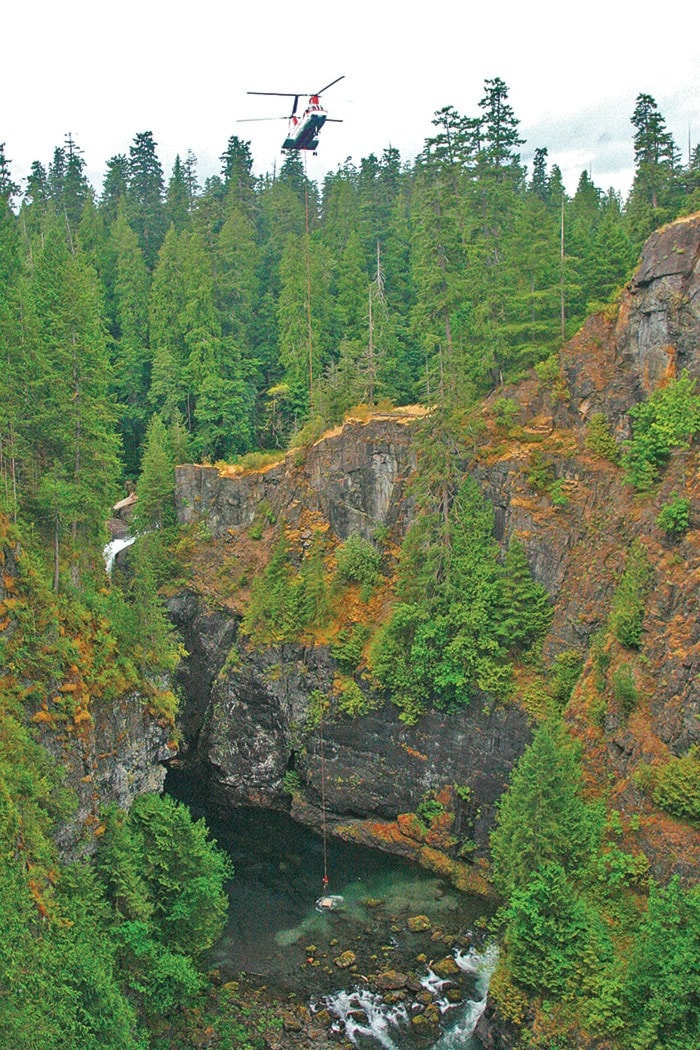People have been going to the Elk Falls suspension bridge in droves since it opened last May, but fish restoration experts hope a different type of bridge will help increase fish numbers in the river below.
It’s about the gravel in the river and fish that use it for spawning. Efficiencies have been found in its delivery to the canyon bottom. A different type of bridge, essentially a skyline, is getting ready to be installed.
The BC Conservation Foundation (BCCF) is leading a spawning gravel placement project that will begin Feb. 22. The first component is construction of a gravel loading pad and access trail on the south side of the canyon and the drilling of steel anchors into the north canyon wall.
A steel cable will be installed to carry a remote release gravel bucket to drop gravel into the river below. The cable will be placed about 30 metres downstream of the suspension bridge.
The cable will only be up when the gravel is being placed so there will be no visual obstructions from the suspension bridge, and the gravel will be brought in using existing and new trails.
“The creation of the John Hart dam in 1947 stopped the natural recruitment of gravel into the canyon from upstream,” BCCF project lead, Jeramy Damborg, said in a press release.
“There’s good fish habitat from the generating station up to Elk Falls. It’s about 1.8 km long and provides spawning and rearing for Steelhead, Coho and Chinook, among other fish. Suitable spawning gravel within the canyon area is a limiting factor to fish production.”
Since 1999, given the importance of gravel for fish productivity, gravel has been delivered six times. The very difficult access with the steep vertical canyon walls has meant the gravel has been delivered in buckets by a heavy lift helicopter, which is expensive with helicopter time costing $2 per second. Safety is another important consideration.
“We are anticipating that once the infrastructure is installed the new gravel placements will be about a quarter of the cost of the previous delivery method,” says Damborg. “That means we can add more gravel on a more consistent basis, hopefully every one to two years.”
Damborg says the gravel, once delivered, slowly moves and spreads downstream when flows released from the John Hart dam are increased.
BCCF is finalizing a Park Use Permit with BC Parks, the landowner, which outlines BCCF as the owner of the gravel delivery asset.
The total project cost is about $161,000. Funding was primarily provided by Fisheries and Oceans Canada, Fish and Wildlife Compensation Program (FWCP) and the Campbell River Salmon Foundation. FWCP has been the primary funding source for all six previous gravel projects in the canyon, and is a partnership between BC Hydro, the Province of B.C., Fisheries and Oceans Canada, First Nations and public stakeholders
“We would like to get the word out that the infrastructure works may last up to four weeks starting Feb. 22,” says Damborg. “We will have signage and sometimes flaggers to keep the public safe along the trail in conjunction of some trail closures or delays on Feb. 23. Then there will be full trail closures to Elk Falls from Feb. 24 to 26; people will be unable to access the falls.
“There may also be some short trail delays as we move equipment and materials in and out during the remainder of the construction period. Noise during drilling operations is also expected. We appreciate people’s patience and apologise for any inconvenience.”
